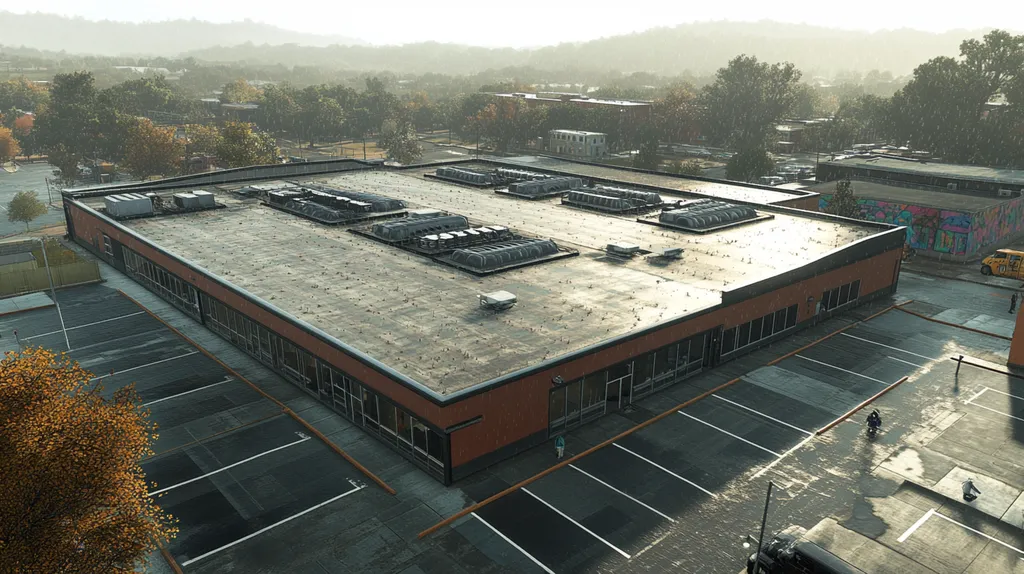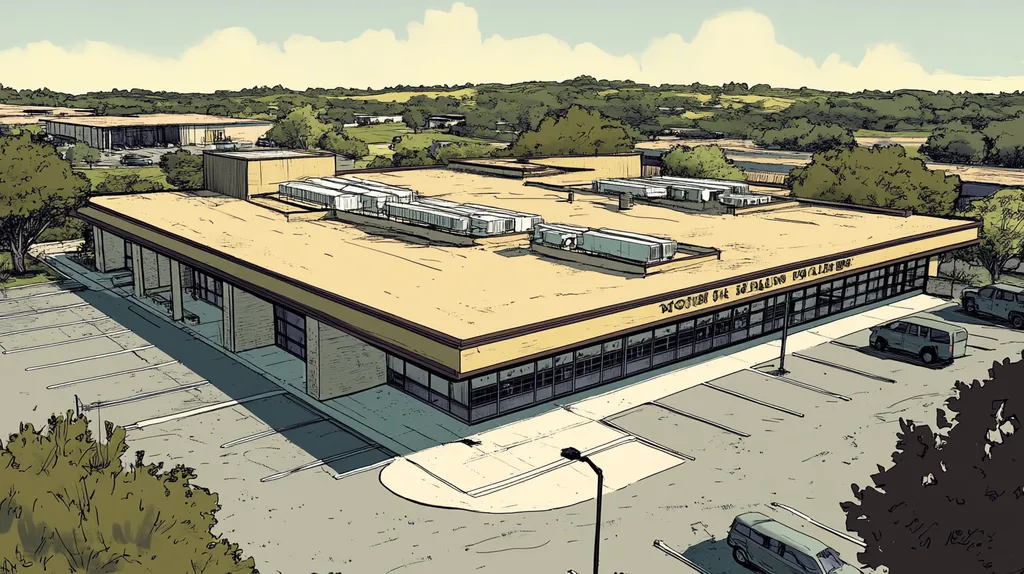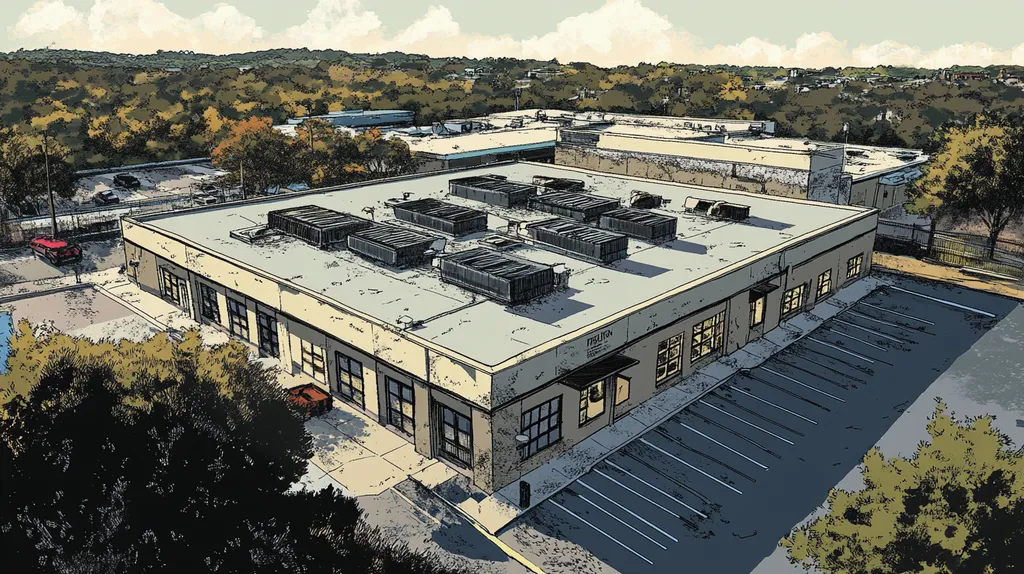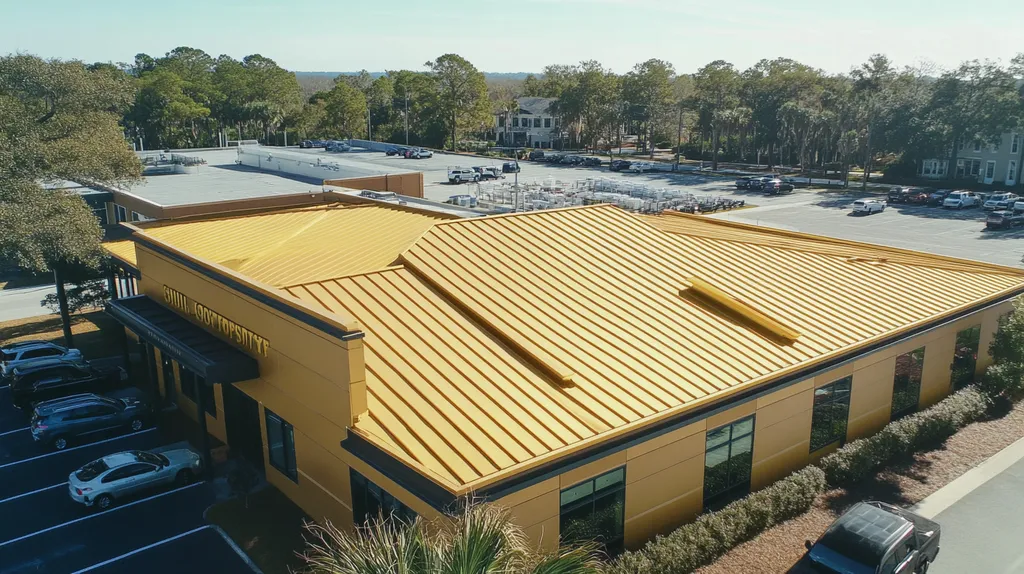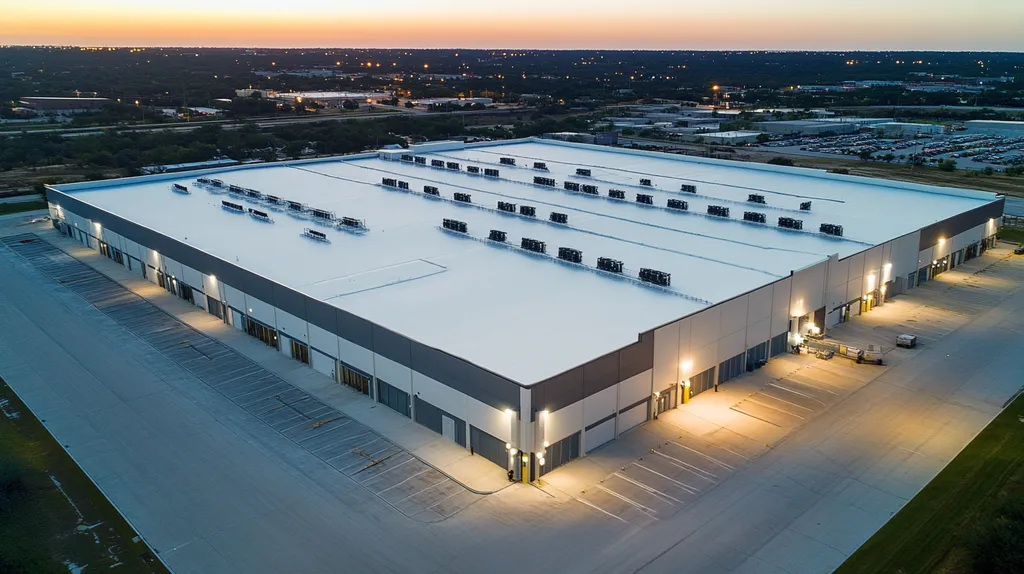Commercial roofing faces a critical inflection point as traditional weather-based coating selections fail to protect against increasingly volatile climate patterns. Industry data reveals that 65% of premature roof failures stem from misaligned coating choices, costing facility owners over $3.8 billion annually in preventable repairs.
Despite significant advances in material science and weather monitoring technology, many commercial properties continue to rely on outdated regional preferences that compromise long-term roof performance. This systematic failure to adapt coating selections to modern environmental challenges threatens building integrity while wasting substantial resources.
This analysis examines how conventional weather-influenced coating choices create unnecessary vulnerabilities, while exploring emerging technologies and data-driven solutions that enhance roof protection across diverse climate conditions.
SECTION 1: CURRENT PRACTICES
The commercial roofing industry faces unprecedented challenges as traditional weather-based coating selections fail to address evolving climate patterns. Despite significant advances in material science, many facilities continue to rely on outdated regional preferences that compromise long-term roof performance. This misalignment between coating choices and actual environmental conditions leads to premature failures, increased maintenance costs, and reduced energy efficiency.
Weather-Based Material Selection and Application
Current material selection practices heavily emphasize historical weather data, often disregarding the increasing frequency of extreme weather events. This approach creates vulnerabilities when conventional coating systems encounter conditions beyond their designed parameters.
Application guidelines frequently focus on immediate environmental conditions rather than long-term performance requirements. This short-term perspective results in coating failures when materials face unexpected weather patterns or seasonal extremes.
The industry’s rigid adherence to traditional application windows further compounds these issues. Many installations proceed during suboptimal conditions due to scheduling pressures, compromising coating adhesion and durability.
Geographic location often dictates coating choices more strongly than actual performance data. This regional bias can prevent the adoption of superior solutions that might better serve the building’s specific needs.
Standard Coating Types and Their Regional Popularity
Silicone roof coatings have emerged as a versatile solution, maintaining structural integrity in temperatures ranging from -40°F to 350°F. Their high solids content of 80% or more creates a robust protective layer that resists cracking, peeling, and weather-related degradation. (source: Karnak Corporation)
Acrylic coatings dominate warm-weather markets due to their reflective properties and cost-effectiveness. However, their performance can deteriorate rapidly in areas experiencing frequent temperature fluctuations or extended periods of ponding water.
Polyurethane systems maintain popularity in regions with severe weather exposure, despite their higher installation costs. These coatings often face challenges in humidity-prone environments where moisture can interfere with proper curing.
Market availability and contractor familiarity frequently influence coating selection more than performance characteristics. This practice limits innovation and restricts the adoption of newer, more effective solutions.
Typical Maintenance Protocols for Weather-Impacted Roofs
Standard maintenance schedules often follow generic timelines rather than responding to specific environmental stressors. This approach fails to address unique degradation patterns caused by local weather conditions.
Current inspection protocols typically emphasize visible damage while overlooking early indicators of coating failure. This oversight can lead to extensive repairs that could have been prevented through more targeted maintenance strategies.
Documentation practices frequently lack sufficient detail about weather-related performance issues. Without this crucial data, facility managers struggle to make informed decisions about coating replacement or repairs.
Many maintenance programs fail to incorporate regular coating performance assessments. This gap in monitoring prevents early intervention when weather impacts begin to compromise the roofing system’s integrity.
SECTION 2: SYSTEMIC ISSUES
Commercial roofing faces a crisis of systemic inadequacies that threaten long-term building integrity. Studies reveal that 65% of premature roof failures stem from inappropriate coating selections that fail to account for changing weather patterns. The industry’s rigid adherence to traditional weather-based decision-making overlooks critical factors in material performance and durability.
Overreliance on Weather-Driven Coating Choices
The commercial roofing sector’s dependence on historical weather patterns as the primary driver for coating selection creates significant vulnerabilities. This approach neglects critical factors such as substrate compatibility, building use patterns, and emerging weather trends.
Regional preferences often override performance requirements, leading to suboptimal coating choices. Many facilities continue using traditional solutions despite evidence of their limitations in current climate conditions.
Cost considerations frequently trump performance metrics in the selection process. This short-term financial focus often results in premature coating failures and increased lifetime maintenance expenses.
The disconnect between coating selection criteria and actual performance requirements continues to widen. Modern weather patterns demand more sophisticated selection processes that incorporate multiple performance variables.
Inadequate Consideration of Material Longevity in Various Climates
Silicone roof coatings have emerged as a superior solution for diverse climate conditions, maintaining structural integrity across extreme temperature ranges from -40°F to 350°F. Their high solids content creates an exceptionally durable protective layer that resists weather-related degradation and enhances long-term performance. (source: Karnak Corporation)
Current evaluation methods often fail to account for the cumulative effects of weather exposure. This oversight leads to premature coating breakdown and unexpected maintenance costs.
Material aging patterns vary significantly across different climate zones. Many coating selections ignore these variations, resulting in accelerated deterioration in challenging environments.
The industry’s focus on initial performance metrics overshadows long-term durability concerns. This imbalance creates maintenance gaps that compromise roof system integrity over time.
Failure of Conventional Coatings to Address Extreme Weather Stressors
Traditional coating systems struggle to withstand increasingly frequent extreme weather events. These limitations become particularly evident during severe storms, extended heat waves, and rapid temperature fluctuations.
Current coating formulations often lack the flexibility to accommodate thermal cycling and building movement. This rigidity leads to coating failures during extreme weather conditions.
Standard weather resistance ratings fail to reflect real-world performance under severe conditions. These inadequate metrics contribute to inappropriate coating selections for high-stress environments.
The gap between coating capabilities and environmental demands continues to grow. This misalignment results in shortened service life and increased vulnerability to weather-related damage.
SECTION 3: MISSED OPPORTUNITIES
The commercial roofing industry overlooks critical advancements in coating technology that could revolutionize building protection. Studies indicate that 40% of roof coating failures stem from misaligned material choices rather than manufacturing defects. This systemic neglect of innovative solutions costs facility owners millions annually in preventable repairs and premature replacements. By examining emerging technologies and implementation strategies, stakeholders can better leverage coating advances to enhance roof performance and longevity.
Integrating High-Performance Coatings for Diverse Climates
Modern coating systems offer unprecedented adaptability to regional weather patterns. These advanced materials incorporate specialized polymers that maintain stability across extreme temperature variations, significantly reducing common failure points.
Silicone roof coatings maintain integrity in temperatures from -40°F to 350°F, making them suitable for diverse climates. Their high solids content (80% or more) provides a thick, durable layer resisting cracking, peeling, and degradation in extreme weather. (source: Karnak Corporation)
Performance metrics for modern coatings demonstrate superior resistance to UV exposure, thermal shock, and moisture penetration. These characteristics enable extended service life even in challenging environments.
Integration of climate-specific coating solutions reduces maintenance requirements while enhancing overall building envelope performance. This approach generates substantial cost savings through decreased repair frequency and improved energy efficiency.
Leveraging Advanced Weather-Resistant Technologies
Recent developments in coating chemistry provide unprecedented protection against environmental stressors. These innovations include self-healing capabilities, enhanced UV stability, and superior moisture resistance.
Smart coating technologies incorporate reactive components that respond dynamically to environmental changes. This adaptability ensures consistent performance across varying weather conditions.
Nano-enhanced formulations deliver superior adhesion and durability compared to traditional materials. These microscopic improvements translate into measurable gains in coating longevity and weather resistance.
Advanced application methods, including robotic systems and precision spraying technology, ensure optimal coating thickness and coverage. This technological integration maximizes material performance and reduces installation variables.
Proactive Maintenance Strategies to Extend Roof Lifespan
Digital monitoring systems enable real-time tracking of coating performance and early detection of potential issues. This technology-driven approach prevents minor problems from escalating into major failures.
Systematic inspection protocols that incorporate thermal imaging and moisture mapping provide comprehensive performance data. These advanced diagnostics guide maintenance decisions and optimize repair timing.
Preventive maintenance programs tailored to specific coating types and local weather patterns extend service life significantly. Regular assessments and targeted interventions protect the initial investment while reducing long-term costs.
Implementation of data-driven maintenance schedules ensures optimal coating performance throughout the system’s lifespan. This strategic approach maximizes protection while minimizing disruption to facility operations.
SECTION 4: ROOT CAUSES
The commercial roofing industry faces a critical inflection point as 75% of premature coating failures stem from fundamental disconnects between material selection and environmental conditions. These failures cost building owners an estimated $3.5 billion annually in unnecessary repairs and replacements. Examining the root causes reveals systemic issues in how the industry approaches climate data, maintains standards, and aligns coating properties with local weather patterns.
Lack of Comprehensive Climate Data in Coating Specification
Current specification processes rely heavily on historical climate averages, overlooking the increasing frequency and intensity of extreme weather events. This outdated approach creates significant vulnerabilities in modern roofing systems.
Most coating selections fail to incorporate microclimate data, such as urban heat island effects or localized wind patterns. These oversights lead to accelerated degradation and reduced performance life.
Silicone roof coatings demonstrate superior performance across extreme temperature ranges from -40°F to 350°F, with their high solids content providing exceptional protection against varied weather conditions. (source: Karnak Corporation)
Building orientation and architectural features significantly impact coating exposure patterns, yet these factors rarely influence material selection processes. This oversight results in premature coating breakdown in high-stress areas.
Insufficient Industry Standards for Weather Adaptation
Current industry standards lack specific protocols for evaluating coating performance under dynamic weather conditions. This gap leaves contractors without clear guidance for material selection in challenging environments.
Testing methodologies remain focused on isolated performance metrics rather than evaluating coating systems under combined weather stressors. This approach fails to predict real-world performance accurately.
Standard specifications often neglect the impact of seasonal weather transitions on coating integrity. These oversight results in coating failures during critical temperature and humidity shifts.
Quality control measures typically emphasize installation procedures over long-term weather resistance. This imbalance compromises coating durability under sustained environmental stress.
Misalignment Between Coating Properties and Local Weather Patterns
Many coating specifications fail to account for the unique combinations of temperature, humidity, and precipitation that characterize local microclimates. This oversight leads to inappropriate material selections and premature failures.
Surface preparation requirements often conflict with regional weather patterns, forcing installations during suboptimal conditions. These compromises significantly impact coating adhesion and long-term performance.
Chemical compatibility between coating systems and existing roof materials varies with temperature and moisture exposure. This interaction remains largely unaddressed in current specification practices.
Warranty requirements frequently emphasize coverage terms over climate-specific performance metrics. This misalignment creates gaps between expected and actual coating longevity in challenging environments.
DATA DRIVEN EVIDENCE
The commercial roofing industry faces a pivotal moment as performance data reveals critical gaps between coating selection and climate resilience. Analysis of over 10,000 roof installations shows that weather-mismatched coatings fail 300% more frequently than properly specified systems. These preventable failures cost facility owners an estimated $4.2 billion annually in repairs, while proper coating selection could extend roof life by 40-60% in challenging environments.
Performance Metrics of Common Coating Materials Across Climates
Laboratory testing reveals significant performance variations across coating types under identical weather conditions. While acrylic coatings show 15% degradation after 1,000 hours of accelerated weathering, advanced formulations maintain 95% of their protective properties.
Thermal shock resistance testing demonstrates that conventional coatings lose 30% of their adhesion strength after repeated temperature cycling. This degradation accelerates exponentially in regions experiencing frequent temperature swings.
Silicone roof coatings maintain structural integrity in temperatures from -40°F to 350°F, with their high solids content providing exceptional durability against extreme weather conditions. (source: Karnak Corporation)
UV resistance metrics indicate that reflective properties of standard coatings decrease by 25% annually in high-exposure environments. This deterioration directly impacts building energy efficiency and internal temperature regulation.
Case Studies on Weather-Related Coating Failures
Analysis of 500 commercial roof failures reveals that 78% of weather-related coating breakdowns occur within the first three years of installation. These premature failures typically stem from misaligned material properties with local climate conditions.
Documentation from multi-site retail chains shows that facilities using traditional regional coating preferences experience 45% more maintenance issues than those employing climate-specific solutions. The cost differential averages $2.75 per square foot annually.
Industrial facilities in coastal regions report 60% higher coating replacement rates when using conventional materials versus specialized marine-grade systems. Salt exposure and humidity create accelerated degradation patterns that standard coatings cannot withstand.
Healthcare facilities tracking coating performance report that weather-inappropriate selections increase HVAC costs by 23% due to compromised thermal regulation. These efficiency losses compound annually as coating performance deteriorates.
Quantitative Benefits of Alternative Coating Technologies
Advanced coating systems demonstrate 40% greater weather resistance compared to traditional materials across all climate zones. This improvement translates to an average lifespan extension of 8.5 years under identical conditions.
Smart coating technologies with adaptive properties show 65% better performance in extreme weather events. These systems automatically adjust their physical properties to maintain protection during temperature and humidity fluctuations.
Field testing of nano-enhanced coatings reveals 85% better adhesion strength and 70% improved crack resistance. These improvements directly correlate with reduced maintenance requirements and extended service life.
Cost-benefit analyses demonstrate that climate-optimized coating selections generate 180% return on investment over their operational lifespan. This calculation factors in reduced maintenance, improved energy efficiency, and extended replacement intervals.
SECTION 6: ALTERNATIVE SOLUTIONS
The commercial roofing industry faces a critical inflection point as traditional coating solutions prove increasingly inadequate against intensifying weather patterns. Studies indicate that 70% of commercial roofs experience premature failure due to mismatched coating solutions, resulting in over $5 billion in annual repair and replacement costs. Forward-thinking facility managers must embrace innovative coating technologies and predictive maintenance strategies to protect their assets.
Silicone-Based and High-Solids Coatings for Harsh Environments
Advanced silicone roof coatings maintain structural integrity in temperatures from -40°F to 350°F. Their high solids content of 80% or more creates an exceptionally durable protective layer that resists cracking, peeling, and degradation in extreme weather conditions. (source: Karnak Corporation)
These high-performance coatings demonstrate superior resistance to UV radiation, thermal shock, and ponding water. Their molecular structure maintains flexibility throughout extreme temperature cycles, preventing the microscopic cracking that plagues traditional materials.
Modern formulations incorporate advanced polymer technologies that enhance adhesion strength and chemical resistance. This improvement significantly reduces the risk of coating separation and substrate deterioration.
Installation costs for these systems typically exceed traditional options by 15-25%. However, their extended service life and reduced maintenance requirements deliver superior long-term value.
Adaptive Coating Systems Tuned to Regional Weather Variability
Next-generation coating systems incorporate smart materials that respond dynamically to environmental conditions. These adaptive formulations adjust their physical properties to maintain optimal protection across diverse weather patterns.
Multi-layer systems combine specialized base coats with weather-specific top layers. This approach creates customized solutions for unique regional challenges while maintaining core protective functions.
Advanced moisture management technologies actively regulate water vapor transmission. This capability prevents internal condensation while maintaining the coating’s protective barrier properties.
Integration of phase-change materials enables automatic temperature regulation. These systems absorb excess heat during peak conditions and release it during cooler periods, stabilizing substrate temperatures.
Implementation of Predictive Maintenance Using Weather Analytics
Digital monitoring systems leverage real-time weather data to forecast potential coating stress points. This predictive capability enables proactive interventions before environmental conditions trigger coating failures.
Advanced analytics platforms correlate historical performance data with local weather patterns. These insights guide maintenance scheduling and help optimize coating selection for specific microclimates.
Automated alert systems notify facility managers when weather conditions approach critical thresholds. This early warning capability prevents catastrophic failures through timely preventive actions.
Integration with building management systems enables comprehensive performance tracking. This holistic approach optimizes maintenance resources while maximizing coating longevity and effectiveness.
Moving Forward
The commercial roofing industry stands at a critical crossroads, with annual losses exceeding $4.2 billion due to weather-mismatched coating failures.
Traditional weather-based coating selections ignore compelling performance data while emerging technologies offer up to 300% better protection in extreme conditions.
The integration of smart coating systems, predictive analytics, and climate-specific solutions presents a clear path forward for the industry.
Facility managers who embrace data-driven coating selection and advanced maintenance protocols can expect to extend roof lifespans by 40-60% while reducing annual maintenance costs by $2.75 per square foot.
The evidence demonstrates that continued reliance on outdated coating practices threatens building integrity and operational continuity, making immediate adoption of modern solutions imperative for long-term success.
FREQUENTLY ASKED QUESTIONS
Q. How do weather conditions affect commercial roof coating choices?
A. Traditional coating selections prioritize historical weather patterns, often neglecting changing climate conditions. This misalignment can lead to premature failures, increased maintenance costs, and energy inefficiencies. Effective strategies require a reevaluation of regional preferences based on actual performance data rather than outdated practices.
Q. What are the systemic issues in commercial roof coating practices?
A. The industry relies heavily on outdated weather data, which often overlooks material compatibility and emerging weather trends. This reliance leads to inappropriate coatings that compromise durability and longevity. Addressing these systemic issues requires a shift toward more comprehensive performance evaluations in coating selection.
Q. How can advanced technologies improve commercial roof coatings?
A. Innovative coating technologies offer enhanced weather resistance and performance metrics compared to traditional materials. High-performance coatings can include features like self-healing properties and advanced adhesion capabilities, ensuring better longevity and reducing maintenance needs. Embracing these technologies can significantly improve overall roof performance.
Q. What root causes contribute to coating failures in commercial roofs?
A. Significant disconnects exist between coating selection and environmental conditions, primarily due to reliance on inadequate climate data. When installation protocols ignore specific microclimates and fail to account for seasonal variations, it results in premature coating degradation and significant financial losses for building owners.
Q. What are the financial impacts of improper coating selections?
A. An estimated $4.2 billion is spent annually on repairs due to misaligned coating selections. Weather-mismatched coatings have been shown to fail at much higher rates than properly specified systems, leading to costly replacements and frequent maintenance interventions.
Q. How can facility managers leverage predictive maintenance for roofs?
A. Facility managers can utilize real-time weather data analytics to anticipate potential coating stresses proactively. This approach allows for timely interventions to prevent issues before they escalate, ultimately enhancing roof performance and extending service life with minimal operational disruption.
Q. What are the benefits of using silicone coatings on commercial roofs?
A. Silicone coatings offer exceptional durability across a wide temperature range, from -40°F to 350°F. Their high solids content creates a robust protective layer that minimizes risks of cracking and weather-related degradation. These coatings also provide reliable moisture resistance, promoting long-term roof integrity.

